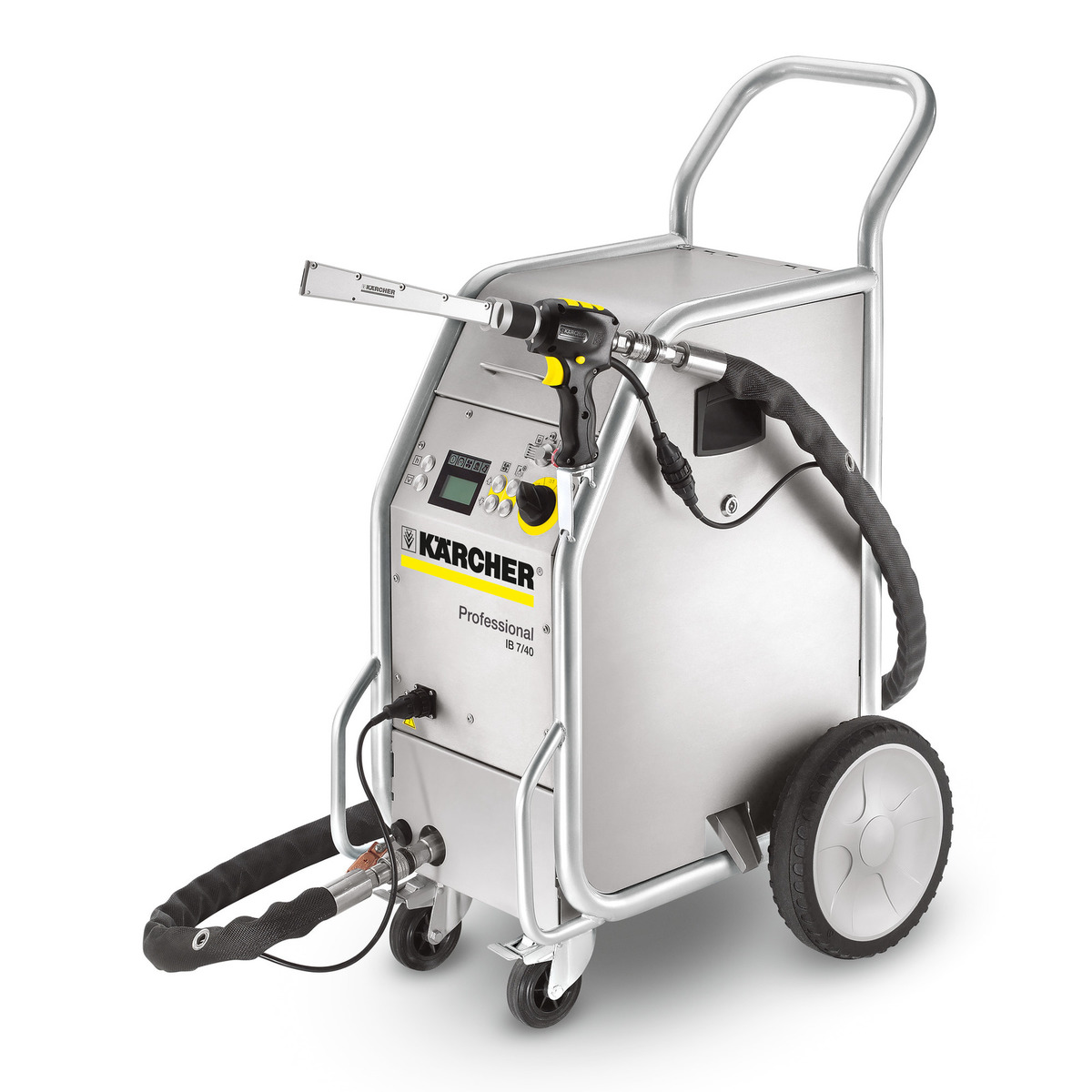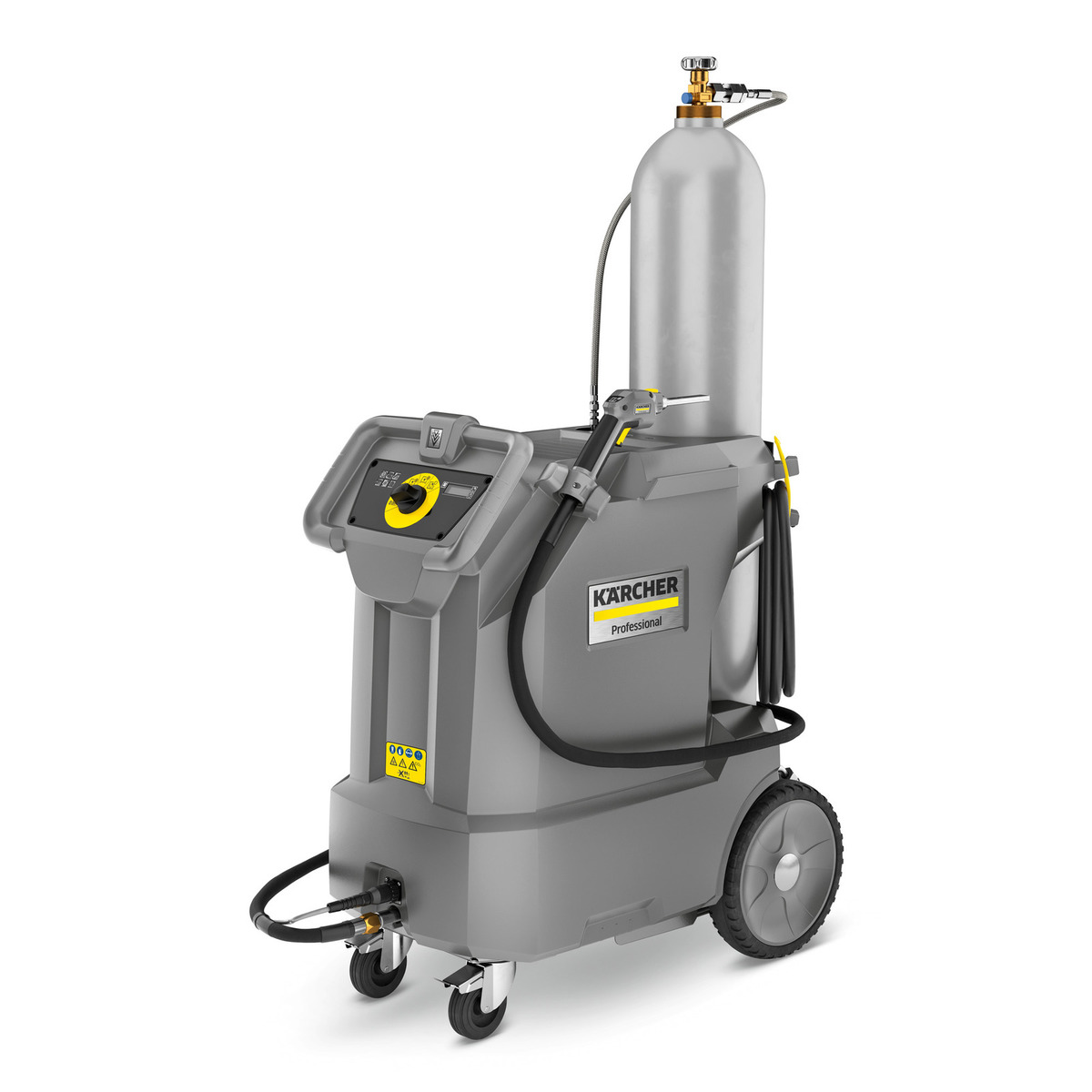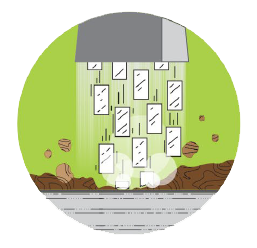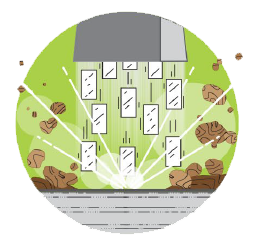Dry Ice Blasters
Also known as CO2 blasting or cryogenic cleaning.
Dry ice blasting, or dry ice cleaning, is similar to sand, bead and soda blasting in that it prepares and cleans surfaces using a medium accelerated
in a pressurized air stream. It differs in that dry ice cleaning uses solid carbon dioxide (CO2) pellets or MicroParticles, accelerated at high
velocities to impinge on the surface and clean it. The particles sublimate upon impact, lifting dirt and contaminants off the underlying substrate without damage.
- Non-abrasive
- Non-conductive
- Non-flammable
- Non-toxic
- Environmentally responsible
The dry ice blasting process does not create secondary waste. The dry ice sublimates, or phase transitions from solid CO2 to gaseous CO2,
when it impacts the surface being cleaned. This eliminates the secondary waste stream that is created with other media blasting techniques.
The only remaining waste products are the dislodged contaminants, which can be vacuumed or swept away.
For information on Dry Ice Blasting systems contact us for information or a quote.

Dry Ice Blaster - IB 7/40 Advanced
The Ice Blaster IB 7/40 Advanced has a jet gun with integrated remote control and also guarantees the best results with dry ice cleaning at low air pressures.
Click for more...

Dry Ice Blaster - IB 10/8 L2P Calssic
The IB 10/8 L2P is the world's first dry ice blaster with integrated dry ice production from liquid CO₂. Perfect for short-term cleaning applications, without complicated logistics.
Click for more...

Dry Ice Blaster - IB 10/15 L2P Advanced
The IB 10/15 L2P Advanced is the latest generation of dry ice blasters with integrated dry ice production. High cleaning performance, ideal for industrial applications.
Click for more...

Dry Ice Blaster IB 15/120
The Ice Blaster IB 15/120 is one of the most powerful dry ice blasting machines on the market. It impresses with its robustness, highly reliable technology and the best results in dry ice cleaning.
Click for more...
How Does Dry Ice Blasting Work?

Impact of pellets creates a Kinetic Energy Effect. The soft dry ice accelerated by compressed air through specially designed nozzles at supersonic speeds.

Cold temperature of dry ice pellets creates a Thermal Effect. The temperature of dry ice (-109°F / -78.5°C) causes the contaminant to embrittle. This helps break the bond between the substrate and teh contaminant.

Expansion of the dry ice pellets. Dry ice pelletes sublimate upon impact, volumetrically expanding in size, removing the contaminant.

Because dry ice is non-abraisive and truns back into gas, you are left with a clean surface, no seondary waste and no damage to your equipment.
How Dose Dry Ice Blasting compare to other cleaning methods?
When comparing dry ice blasting to other cleaning methods, such as abrasive blasting (sand, bead, etc), soda blasting, pressure washing, chemical solvent washing and manual hand tools, it is important to ask the following questions of each:
- Is it abrasive?
- Does it create secondary waste?
- Is it environmentally responsible?
- Is it toxic?
- Is it electrically conductive?
The attributes of each cleaning method not only affect the cleaning result, but also dramatically affect the surface area being cleaned, the surrounding area and the safety of the person performing the cleaning.
Dry Ice Blasting vs. alternative cleaning methods.
| Cleaning Method |
Abrasive |
Secondary
Waste |
Environmentally
Responsible |
Toxic |
Electrically
Conductive |
| Dry Ice Blasting |
No |
No |
Yes |
No |
No |
Abrasive Blasting |
Yes |
Yes |
No |
* |
No |
| Soda Blasting |
Yes |
Yes |
No |
* |
No |
| Solvent/Chemical |
No |
Yes |
No |
Yes |
N/A |
| Hand Tools |
Yes |
No |
N/A |
N/A |
N/A |
|
* Upon contact, the media becomes contaminated when used to clean hazardous substances and objects.
These blasting materials are also then classified as toxic waste and require appropriate safe disposal.
|
Who uses dry ice blasting?
Dry ice blasting is used for a wide variety of cleaning, surface preparation and parts finishing applications in a diverse range of industries.
- Aerospace
- Automotive
- Contract Cleaning
- Composite Tool Cleaning
- Electric Motor
- Engineered Wood
- Fire Restoration
- Food and Beverage
- Foundry
- General Maintenance & Facilities
- Historical Restoration
- Medical Device Manufacturing
- Mold Remediation
- Oil and Gas
- Packaging
- Plastics
- Power Generation
- Printing
- Rubber
- Textile
What do I need to begin dry ice blasting?
Dry ice blasting requires a simple setup
Along with your dry ice blasting machine, the systems will come complete with a blast and air hose, an applicator and a nozzle that is best suited for your application.
The only other items needed to operate the system are:
- Compressed air source (either plant air or an air compressor)
- Electric power source
- Dry ice supply
An after cooler may be useful if you are using a portable diesel compressor as your air source. An after cooler removes most of the moisture from the system and can cool the air within 15°F (-9.4 °C) of the surrounding air. This is primarily dependent on humidity levels.
Air pressure requirements
Dry ice blasting systems using pellets typically consume 100 cfm (2.8 m3/min) at 80 psi (5.5 bar), while MicroParticlesystems typically consume 30 cfm (0.9 m3/min) at 80 psi (5.5 bar). Low flow nozzles for the MicroParticle systems can consume as little as 12 cfm (0.3 m³/min) at 80 psi (5.5 bar). However, your needs will depend on your application.
For information on Dry Ice Blasting systems contact us for information or a quote.
Where do I get dry ice?
Dry ice pellets or blocks can be ordered from industrial gas suppliers, welding supply companies and other regional suppliers. Dry ice can be picked up directly from suppliers, or most major metropolitan areas have regular delivery trucks that cover 100 mile radiuses. Dry ice can also be shipped using a common carrier and it is delivered in insulated containers.
How do I store dry ice and how long does it last?
Dry ice should be stored in an insulated container, which is provided by the supplier and picked up by them when needed. The thicker the insulation, the slower the dry ice will sublimate. Depending on the climate and thickness of your container, dry ice sublimation is approximately 2% to 10% per day.
How much dry ice do I need?
The amount of dry ice needed to clean effectively varies from application to application and also can vary dramatically with each dry ice blasting system.
The average dry ice consumption for dry ice blasting equipment will range from approximately 0.7 lbs (0.32 kg) per minute for a MicroParticle system to 2 1/2 lbs (1.1 kg) per minute for a pellet system.
How much does dry ice cost?
Dry ice is a commodity and prices vary geographically.
Can I make my own dry ice?
Dry ice can be produced on demand using a dry ice production machine, also known as a pelletizer. Producing your own dry ice must be economically viable and the amount of dry ice used on a daily and weekly basis must be considered.
Pelletizers can be equipped with multiple dies to produce a range of extrusion sizes (3mm to 19mm). From nuggets to pellets, pelletizers can produce multiple sizes of dry ice for a broad range of solutions.